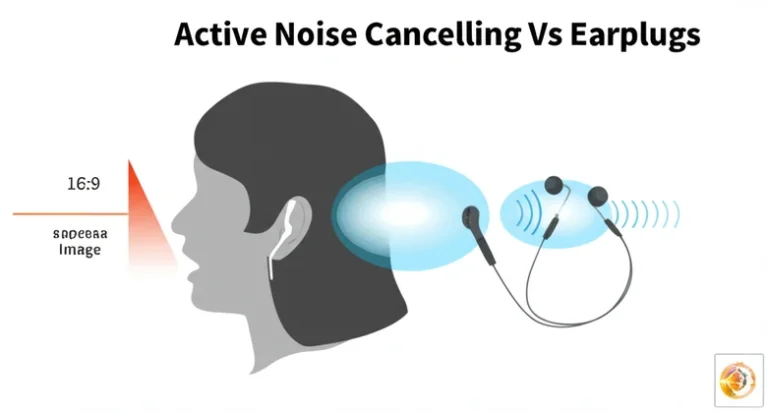
Noise-cancelling technology, a marvel of modern acoustics, uses principles of physics to reduce unwanted noise, dramatically improving our auditory experience in various environments. This article delves into the physics behind noise cancellation, exploring how it works to create oases of quiet in our increasingly noisy world. Understanding how does noise cancelling work in physics involves exploring both active and passive noise reduction techniques, each employing distinct yet complementary scientific concepts.
From minimizing the drone of airplane engines to enhancing focus in bustling offices, noise-cancelling technology has become indispensable.
But how does it actually work? This article will unpack the science behind this technology, examining its mechanisms, applications, limitations, and future potential.
The Basics of Noise Cancelling
Noise-cancelling technology aims to reduce or eliminate ambient noise using a combination of physical and electronic methods. These methods are broadly classified into two main categories: active noise cancellation (ANC) and passive noise cancellation.
Active Noise Cancellation (ANC)
ANC utilizes the principle of sound wave interference to neutralize unwanted noise.
Small microphones embedded within the device (e.g., headphones, earbuds) capture ambient sounds. A specialized processor analyzes these sounds and generates an “anti-noise” wave – a sound wave with the same amplitude but inverted phase – which is then emitted through the device’s speakers. This effectively cancels out the original noise, creating a quieter listening experience.
ANC is particularly effective against consistent, low-frequency sounds like engine hums or the drone of airplane engines.
Passive Noise Cancellation
Passive noise cancellation employs physical barriers and sound-absorbing materials to block sound waves from reaching the ear. This method relies on the properties of materials like dense foam, specialized fabrics, and carefully designed earcup structures to absorb or deflect sound energy. While passive noise cancellation does not involve any electronic processing, it is generally more effective at attenuating higher-frequency noises like speech and sudden sharp sounds.
It also provides some reduction across the frequency spectrum.
The Physics Behind Noise Cancelling
Noise-cancelling technology is firmly grounded in the physics of sound waves and their interactions. To understand how these technologies work, we must first understand the nature of sound itself.
How Sound Waves Work
Sound waves are longitudinal waves, meaning the vibrations travel in the same direction as the wave’s propagation. They are characterized by several key properties:
- Frequency: Measured in Hertz (Hz), frequency represents the number of oscillations per second and determines the perceived pitch of a sound.
Higher frequencies correspond to higher-pitched sounds.
- Wavelength: The distance between two consecutive corresponding points on a wave (e.g., two consecutive crests). Wavelength is inversely proportional to frequency: longer wavelengths correspond to lower frequencies, and vice-versa.
- Amplitude: Represents the magnitude of the wave’s displacement from its equilibrium position and corresponds to the perceived loudness of a sound. Higher amplitude means a louder sound.
- Phase: Describes the position of a point on the wave cycle at a specific moment in time.
Two waves are “in phase” if their crests and troughs align, and “out of phase” if they are offset.
- Speed: The rate at which the sound wave propagates through a medium. The speed of sound depends on the properties of the medium (e.g., temperature, density).
Destructive Interference
ANC exploits the phenomenon of destructive interference to reduce noise. Destructive interference occurs when two waves of equal amplitude and frequency meet but are 180 degrees out of phase.
This means the crest of one wave aligns perfectly with the trough of the other. The superposition of these two waves results in a net cancellation, effectively reducing the overall amplitude and thus the perceived loudness. This principle is fundamental to how ANC functions.
Imagine one wave pushing air molecules forward while another simultaneously pulls them backward with the same force.
The net result is no movement of the air molecules, hence, no sound. This is a simplified illustration of destructive interference.
Sound Absorption
Passive noise cancellation relies on sound absorption, the process by which sound energy is converted into other forms of energy, primarily heat. Materials used for passive noise reduction are designed to minimize sound reflection and maximize absorption.
The effectiveness of a material at absorbing sound is often described by its Noise Reduction Coefficient (NRC), a value between 0 and 1, with higher values indicating greater absorption.
Active Noise Cancelling in Action
The Role of Microphones and Processors
In ANC devices, microphones continuously sample the ambient noise. This audio signal is then fed to a digital signal processor (DSP). The DSP analyzes the noise and generates an anti-noise signal – a wave of equal amplitude but opposite phase – which is sent to the device’s speakers.
This process occurs in real-time, allowing the ANC system to continuously adapt to changes in the surrounding noise.
Effectiveness Against Low-Frequency Noises
ANC systems are most effective at reducing consistent, low-frequency sounds, such as:
- Airplane engine noise
- Traffic hum
- The drone of machinery
Limitations
ANC is less effective against:
- High-frequency sounds: These have shorter wavelengths, making it more challenging for the ANC system to accurately generate the anti-noise signal.
- Transient or unpredictable noises: Sudden sounds like voices, door slams, or other abrupt noises are difficult for ANC systems to process and cancel effectively due to their short duration and variability.
Passive Noise Cancelling and Its Physics
How Materials Block Noise
Passive noise cancellation utilizes materials that impede the transmission of sound waves. Dense materials, like thick foam or specialized acoustic fabrics, effectively absorb sound energy. The design of the earcups or other barriers also plays a crucial role, creating a physical barrier to prevent sound waves from reaching the ear.
Different materials exhibit varying degrees of sound absorption across the frequency spectrum.
Practical Examples
- Over-ear headphones: Insulated earcups with dense padding create a sealed environment around the ear, effectively blocking external sounds.
- In-ear earphones: Utilize ear tips made of materials like silicone or foam to create a seal within the ear canal, preventing external noise from entering.
- Building insulation: Materials like fiberglass or mineral wool are used in walls and ceilings to absorb sound and reduce noise transmission between rooms or from the outside environment.
Applications of Noise Cancelling Technology
Consumer Electronics
Noise-cancelling technology is prevalent in consumer electronics, primarily in headphones and earbuds. These devices provide a significantly improved listening experience for music, podcasts, and phone calls by reducing background noise.
Transportation
ANC systems are increasingly integrated into vehicles, including cars and airplanes, to reduce engine noise and create a more comfortable travel experience for passengers. This technology can significantly reduce driver fatigue and enhance overall passenger well-being.
Industrial Settings
Noise cancellation plays a vital role in protecting workers in loud industrial environments.
A combination of ANC and passive noise reduction techniques, such as soundproof barriers and earmuffs, is employed to mitigate the risk of hearing damage in factories, construction sites, and other noisy workplaces.
Innovations and Future of Noise Cancelling
The field of noise cancellation is constantly evolving, with ongoing research and development focused on enhancing existing technologies and exploring new applications.
Advanced Algorithms
Advanced algorithms, including those based on artificial intelligence (AI) and machine learning, are being developed to improve the effectiveness of ANC systems, particularly in dynamic and complex noise environments. These algorithms can adapt more quickly and accurately to changing noise profiles, offering a more personalized and seamless noise-cancelling experience.
Expanding Applications
Researchers are exploring new applications of noise-cancelling technology beyond headphones and vehicles.
This includes developing noise-cancelling windows for homes and offices, noise-reducing materials for furniture and interior design, and smart home devices that can actively manage and control noise levels within a living space.
Sustainability
The development of sustainable and environmentally friendly materials for passive noise cancellation is also gaining traction. Researchers are investigating bio-based and recycled materials that offer comparable or even superior noise reduction properties while minimizing environmental impact.
FAQ
What is destructive interference in noise cancelling?
It occurs when two sound waves of the same frequency and amplitude meet but are 180 degrees out of phase. The crest of one wave aligns with the trough of the other, resulting in a net cancellation of the sound.
Why doesn’t ANC work for all sounds?
ANC is most effective against consistent, low-frequency sounds. It struggles with high-frequency and transient noises because these sounds have shorter wavelengths and more complex waveforms, making it challenging for the ANC system to generate a precise anti-noise signal.
Can noise cancelling harm your ears?
No, noise-cancelling technology itself is safe for your ears.
In fact, it can protect your hearing by reducing the need to listen at high volumes in noisy environments.
How much noise can ANC cancel in decibels?
The amount of noise reduction achieved by ANC varies depending on the device and the specific noise environment. Most ANC headphones reduce noise by 20-30 dB, while some high-end models can achieve up to 40 dB of noise reduction.
Do noise-cancelling headphones work without music?
Yes, ANC functions independently of any audio playback.
You can activate noise cancellation without playing music or other audio to enjoy a quieter environment.
Conclusion
Noise-cancelling technology represents a powerful application of physics, leveraging the principles of destructive interference and sound absorption to enhance our auditory experience in various settings. From consumer electronics to transportation and industrial safety, noise cancellation plays an increasingly important role in our modern world. As research and innovation continue, we can expect further advancements in this field, leading to even more effective and versatile noise-cancelling solutions for a wider range of applications.
Understanding how does noise cancelling work in physics allows us to appreciate the sophisticated interplay of science and engineering that makes this technology possible.






